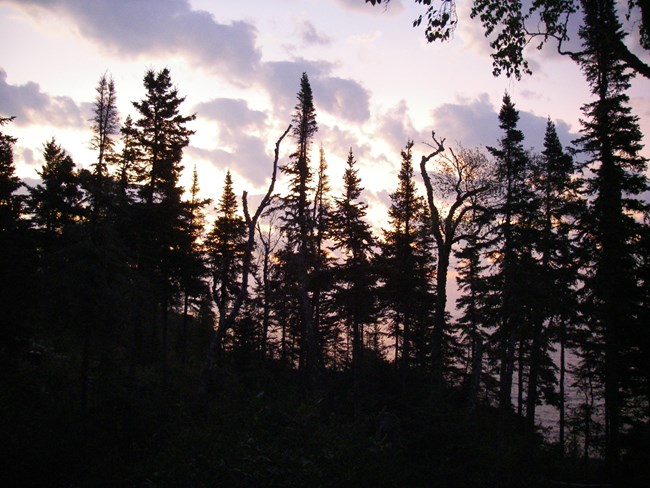Last updated: May 11, 2022
Article
Songbird Monitoring at Apostle Islands, 2014-2018

NPS/T. Gostomski
Say, what about those birds? Who are they? How many different kinds are you hearing? Do you recognize any of the songs as ones you hear at home?
The National Park Service has monitored songbird populations in the islands since 1990. The variety of habitats found in the islands providing nesting areas for more than 100 species of songbirds. Surveys are conducted in June during the first four hours of daylight. Observers spend ten minutes at each of 76 survey points spread across seven islands and the Mainland Trail.

Photos ©Flickr/ksblack99, Wikimedia Commons/D. Daniels, Wikimedia Commons/J. Benson, USFWS/G. Gentry, Wikimedia Commons
2014–2018
Fortunately, we don’t have to identify 100 different bird species each morning. A recent analysis of data collected from 2014 through 2018 revealed an average of 63 species heard at the survey points each year (range =54 to 73). The five most commonly heard species were the Black-throated Green Warbler, Ovenbird, Red-eyed Vireo, Common Yellowthroat, and Nashville Warbler. This list of top species has remained consistent for almost 30 years! In 1990, the top five species were Ovenbird, Red-eyed Vireo, Red-winged Blackbird, Black-throated Green Warbler, and Nashville Warbler.
Photos ©Flickr/ksblack99, Wikimedia Commons/J. Benson, NPS photo.
The populations of 10 species increased during that five-year period, but only three of those were statistically significant: Red-eyed Vireo (+19 individuals/mi2/year), Black-throated Green Warbler (+14 individuals/mi2/year), and Black-and-white Warbler (+4 individuals/mi2/year). Only the American Robin showed a declining population trend, but it was not statistically significant.
A guild is a group of species that share a common trait such as habitat type, nest location, or food source. All guilds at Apostle Islands exhibited increasing population density trends, ranging from +1 bird/mi2/year (permanent resident species) to +23 birds/mi2/year (successional/agricultural/scrub habitat species). Statistically significant trends were observed among birds that forage in the upper canopy (+9 individuals/mi2/year) such as the Black-throated Green Warbler, Northern Parula, and Red-eyed Vireo, and urban species (+1 bird/mi2/year) such as the Chipping Sparrow, American Robin, and Blue Jay.

Map from Birds Canada, "NABCI Bird Conservation Regions."
www.birdscanada.org/bird-science/nabci-bird-conservation-regions/
Comparisons with the North American Breeding Bird Survey (2005–2015)
The increase in Black-throated Green Warblers in the Apostle Islands mirrors an increasing trend in Wisconsin, but the species is showing a slight decline across the region (see map) and the United States (2005–2015 North American Breeding Bird Survey data, www.mbr-pwrc.usgs.gov/bbs/specl15.shtml). The Red-eyed Vireo is increasing at all three scales (state, region, and U.S.), while the Black-and-White Warbler is showing declines at all three scales.
Comparing the trends we see in data from park surveys with those identified in North American Breeding Bird survey data is only intended as a general comparison. However, the difference in trends does illustrate how the Apostle Islands provide a refuge for some species, a place where their populations are able to flourish in contrast to what’s happening beyond the lakeshore’s borders.
The Future of Bird Song in the Apostles
So, as you’re enjoying the sunrise during a visit to the Apostle Islands, some of those birds you hear are the same ones you can hear at home—American Robins and Song Sparrows, for example—but others, such as Canada Warblers and Northern Parulas, are unique to the northern forest, and they thrive here in the Apostle Islands. Will they continue to thrive?One study comparing bird population changes under two different climate scenarios predicted high turnover of species populations in the Apostle Islands by mid-century (2041–2070) if the nation continues on its current path of rising emissions1. The American Robin is one of four species whose populations are predicted to decline in the Apostle Islands during the breeding season under either climate scenario (along with Blue-winged Teal, Cedar Waxwing, and Northern Harrier). The list of species whose populations are predicted to increase in the Apostles under either scenario is longer: American Goldfinch, Baltimore Oriole, Barn Swallow, Brown Thrasher, Common Grackle, Downy Woodpecker, Eastern Kingbird, Eastern Meadowlark, European Starling, Gray Catbird, House Wren, Indigo Bunting, Red-winged Blackbird, Ring-necked Pheasant, Rock Pigeon, and Warbling Vireo. All but the European Starling are native to North America, so the “new” species are not new to Wisconsin. In fact, you can find them in northern Wisconsin now, but we may see much more of them in the Apostle Islands in the coming years and fewer of the birds that depend solely on northern forests and a cooler, wetter climate.
